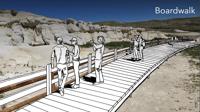Long-anticipated master plans approved for 2 Colorado Springs area parks
Long-anticipated master plans for two cherished Colorado Springs area parks have gained final approvals.
El Paso County commissioners this week unanimously voted in favor of guiding documents for the future development and management of Paint Mines Interpretive Park as well as for Jones Park.
The plan for the latter — the nearly 1,200 acres tucked high in the Bear Creek watershed, popularly accessed from North Cheyenne Cañon — has been many more years in the making.
For Cory Sutela, Jones Park has been the center of complicated advocacy for more than 10 years, back to when a lawsuit against the U.S. Forest Service spurred action to protect an endangered species of greenback cutthroat trout. The executive director of mountain biking group Medicine Trail Advocates was at the recent commissioners meeting to stump for one last change to Jones Park’s 97-page master plan, following several years of changes.
For advocates like Sutela, those changes have underscored tensions between the land’s county ownership and the federal government’s oversight.
Master plan proposed for Paint Mines near Colorado Springs, not all happy with it
The last change “more clearly asserts the rights of the county and its citizens to maintain local control within the structure of the federal process we have to follow,” Sutela explained to commissioners.
For the construction of any “aspirational trails” mapped in the master plan, “consultation” is required with the Forest Service. The agency in 2016 finalized a document outlining protection of the Bear Creek habitat, following a conservation easement set by Palmer Land Conservancy.
The local conservancy has indeed called for the county’s consultation with the Forest Service regarding developments outside the scope of the 2016 document. But Sutela and other advocates see “consultation” as vague and the Forest Service as too under-resourced and too overburdened by costly, time-consuming regulations.
Hence the change approved by commissioners, who were advised by a county attorney at the meeting: language stating “Palmer Land will confirm (consultation) has occurred, and that the results of the consultation have been considered and are consistent with the terms of the conservation easement.”
The upshot, Sutela said: “We want to make it really clear there are (proposed) trails developed through a public process that cannot be built yet, but there is a pathway, and we have a defined process.”
The master plan calls for other to-dos in line with the Forest Service’s 2016 vision: some minor trail reroutes, restoration, continued monitoring of “social” trails and continued maintenance of the trail known as Captain Jacks.
Jones Park underscored what Commissioner Stan VanderWerf called “broader strategic issues” existing along the shared boundaries of the Forest Service and a growing metro population with varying interests.
“I do believe there is a future pathway for a lot of these equities to be addressed fairly,” VanderWerf said. “But there are so many encumbrances, so many challenges, so many equities, and this is why it’s always been hard to deal with.”
For El Paso County’s parks department, Paint Mines Interpretive Park has similarly posed challenges.
In the years of the COVID-19 pandemic, onlookers feared degradation as record crowds descended upon the colorful, geologic expanse near Calhan.
The past year of analysis, public meetings and surveys was meant “to bring Paint Mines Interpretive Park into a more modern era,” said county parks’ Ross Williams, “and to really deal with the pressure of our more robust population here in the county and on the Front Range.”

Boardwalks are one protective measure proposed as part of a master plan for Paint Mines Interpretive Park east of Colorado Springs.
Courtesy of DHM Design

Boardwalks are one protective measure proposed as part of a master plan for Paint Mines Interpretive Park east of Colorado Springs.
A series of social trails wander around the park, the plan states. Many “lead to the top of the hoodoos” and “are quickly degrading the formations, often leading to the collapse of geologic features that have been standing as a part of the landscape for thousands of years.”
The plan identifies boardwalks and “low-barrier” fencing and chain-link posts “that doesn’t impede the views, but just helps direct visitors on where they’re supposed to go in the park, and also helps protect those geologic features,” said Ashleigh Quillen with contractor DHM Design.
The 108-page plan envisions a new main hub: “the overhead trailhead” up the road from today’s popular launchpoint, what’s referred to as the “north trailhead parking lot.” That dirt parking lot will maintain its size and be paved, while the overhead trailhead parking lot will be larger with 73 paved spots. The parking lot could also be home to a visitor center, pending funds.
Jones Park plan closer to approval; Colorado Springs trail enthusiasts push back
For all improvements listed in the master plan, estimated costs run close to $7 million. That has been a concern for advocates who see an underfunded county parks department.
The plan was “great,” said Trails and Open Space Coalition Executive Director Susan Davies.
“If we have one concern, it’s how are we going to get it done? Because it’s imperative we get it done,” she said. “We need to make sure we protect this place for generations to come.”
Asked about costs, a county spokesperson previously told The Gazette: “Master plans are not intended to be implemented immediately. We will prioritize protecting the formations with the recommended approaches outlined in the master plan.”




